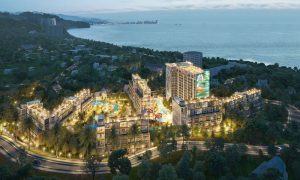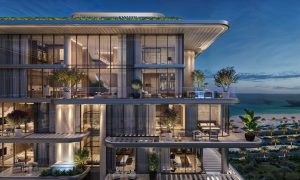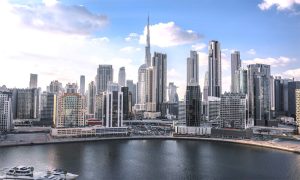Full circle
Goettsch Partners’ Steven M Nilles, on the division of responsibilities within the architecture profession

As the saying goes, a jack of all trades is a master on none. But one architect begs to differ.
Flying in the face of a zeitgeist that has fragmented the architecture community into a plethora of ‘specialist’ firms, Goettsch Partners managing partner and head of Middle East operations, Steven M. Nilles, says the key to successful project execution is to be there from start to finish.
“It seems like our profession right now is split into a lot of specialist design firms. Some do design and then there will be another firm that does construction documents, and another in construction administration, but whenever possible we like to do the whole thing,” he explains, describing the company dynamic as one that operates like a small business but works on big projects; with 85 architects across offices in Chicago, Shanghai and, most recently, Abu Dhabi.
“We go from A to Z in terms of architectural services,” he adds.
In his role, that also incorporates technical design principle responsibilities, Nilles and partner Jim Goettsch complement each other’s skills to provide clients with a single point of contact on projects, for a range of elements and disciplines.
“In terms of concept he is the lead but we work together on a design to technical and technical to design level and I think that’s what makes Goettsch Partners different. We go back to the old way of doing things in a very contemporary way, in terms of utilising technology,” Nilles continues.
It’s an approach that has seen the firm appointed to regional projects that include Riyadh’s Hilton Hotel and Residence and Windham Grand at King Abdulla Financial District (KAFD), in addition to Sowwah Square and Sowwah Island’s Al Hilal; all since arriving only seven years ago.
It’s also an approach that is mirrored in the scope of work each of the firm’s architects can execute. With Nilles describing himself as the person who goes from massing models and concept drawings to the critique and quality assurance of value engineering and finished project sign off, he adds that everybody in the firm – and those receiving mentoring from them – approach work in the same way.
“You see the big picture, you understand the efficiency, you see the planning and expertise. The details are what fall down a lot,” he says of the benefits.
Essential Basis
It was after a heady 16 years with Murphy/Jahn, working on projects such as Messe Tower, Frankfurt; The Kempinski Hotel and MAC, Munich; and the Sony Centre at Potsdammer Platz, Berlin, that Nilles stopped long enough to take stock.
Realising he had only worked on a single project in his home town of Chicago – United Terminal 1 at O’Hare International – he joined forces with Jim Goettsch, with whom he has now worked with for more than 20 years, to establish Goettsch Partners as it is today.
After an initial project in Prague, the new firm went on to design and deliver three high-rise office towers that “redefined the Class A+ market for Chicago”.
“The synergy between design, leasing, construction, delivery and sales was as good as it gets,” Nilles says as he reflects on the period.
The projects would form an essential basis for the next chapter in both men’s careers when, in 2005, Goettsch Partners won the design competition for the new home of the Abu Dhabi Exchange (ADX), Sowwah Square, and as a result opened the firm’s third office dedicated to serving the Middle East.
The initial Sowwah Square contract was for a one year design process and documentation for the ADX building and four surrounding office towers, with Oger Abu Dhabi already negotiated to build the project.
“Working hand in hand on site with other design professionals, subcontractors, and material suppliers from all over the world, and trying to communicate in numerous languages to get things built right was an experience beyond imagine, most rewarding and a foundation to build from here in the Gulf States,” Nilles recalls.
As the collaborative process strengthened working relationships, the scope of works under the contract also grew and came to involve the full project lifecycle.
“Jim Goettsch is very astute in really maximising the potential of every project and this one had big potential,” says Nilles.
“For a long time we studied what would happen at the base of these buildings. Not just what goes in them, but what surrounds them. We transferred all the buildings onto columns, really to create spaces within spaces,” he adds.
It’s a formula the firm had wanted to apply to the 65 storey, 111 South Wacker, in Chicago. The original design stood the tower on a 20 metre by 20 metre core, springing to the first office floor 12 levels above the plaza on a tight quarter block corner site. But market demand post 9/11 prevented this early design ever living beyond the drawing board.
“The market place perception of risk caused us to modify the design. In retrospect, a core-only supported tower performs better to mitigate a plausible destructive threat compared to a conventionally structured building. But market perception, even though technically unfounded, is a very powerful force,” he says.
In the case of Sowwah Square, all office tower columns are transferred into the core below level eight, so equal and opposite tension and compression reactions cancel each other out, thus providing an efficient structural transfer.
While Nilles admits there’s a significant cost premium attached to such design, the vision of the client, Mubadala Real Estate and Infrastructure, allowed project budgets that were “truly deserving of what we were trying to accomplish,” and created a “product that will endure”.
Image Creation
For Nilles the ability to create such products again stems from the multi-disciplinary approach that also sees the firm assessing the economic feasibility of projects in the same way it will analyse the environmental impact and architectural statement at hand.
“A lot of architects are focused on the image of towers and certain selected spaces. But in addition to all of that is the financial aspect of sustainable development,” he explains, later reiterating the importance of the use of surrounding space and underlining the consequences of building what a market already has.
It was market influences that teased Nilles’ attention away from the speculative US market to Europe, where he witnessed a heightened demand for quality and durability, elaborating: “The European market was focused on a higher level of sophistication and appreciation in design and a longer outlook on value and income producing properties.”
They are lessons he then applied to his work with Goettsch Partners, particularly Sowwah Square; the remit for which was to create an image for the Emirate’s – and indeed country’s – financial industry, a task Nilles describes as “creating our own urban context”.
“Every market has its advantages but we took everything we learned in US and European markets and applied that, and then a lot more, to our work here in the Gulf market,” he asserts.
“Here there is a level of stability of planning and fiscal responsibility, and while I wouldn’t call it conservative, there is an entrepreneurial spirit here that is measured.
“When they have to make changes, they will make changes and re-direct focus if needed, but it all goes back to the 2030 plan; the vision of Sheikh Zayed and the transformation of a country that is only 40 years old,” he says, praising the 2030 economic plans as being so comprehensive they formed a large reason for Goettsch Partners establishing its regional base in the Emirate.
“We feel very fortunate to be a part of that. We see and understand and now we have lived here as expatriates, there is a level of meaning that you absorb from that experience in terms of opportunities and as architects you have to understand all of that.”
End Result
Little has been written about Nilles in the past, but as the man leading Goettsch Partners’ growing Gulf operations, that could be about to change.
Specialising in high-rise buildings that integrate advanced engineering with new materials and sustainable strategies, beyond the US and Gulf, he has worked in Prague, China and Poland.
Nilles has also been elected to the American Institute of Architects (AIA) College of Fellows and has four times received the AIA Chicago Divine Details Award, in addition to the first Chicago Innovation Award ever presented to an architect. Despite his vast portfolio of experience, Nilles still doesn’t have a rehearsed answer to the question of which of his projects qualifies as a favourite.
“As a father of five children each child is my favourite in many ways. The same holds true for an architect and his projects, as each one has its own potential. As a lead consultant it is your responsibility to maximize that specific opportunity.
“For those design professionals who have had the fortune of working with great clients and the resultant quality projects, after about the first dozen you start to value more and cherish the journey and not just evaluate the end result,” he concludes. n
























